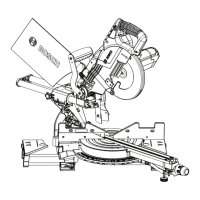37
Compound Cuts
A “compound cut” is a cross-cut made with the
blade both at a miter angle and at a bevel angle.
Because it may take several tries to obtain the
desired compound angle, perform test cuts on
scrap material before making your cut.
FOLLOW THESE INSTRUCTIONS FOR MAKING
YOUR COMPOUND CUT:
1. Extend the left base extension and left sliding
fence (See “Sliding Fence and Base Extension”
on pages 30 and 31)
2. Properly position workpiece. Make sure
workpiece is clamped firmly against the table or
the fence (figure 43).
Use clamping position that
does not interfere with
operation. Before switching on, lower head
assembly to make sure clamp clears guard and
head assembly.
Be aware of the path of the
saw blade. Make a dry run
with the saw Off by conducting a simulated
cutting cycle, and observe the projected path of
the saw blade. Keep hands at least six (6) inches
away from the projected path of the saw blade.
3. Set miter and bevel angles according to the
instructions on page 35 and 36 for miter and
bevel cuts.
4. Follow the procedures for chop cut or slide cut.
5. Wait until blade comes to a complete stop before
returning head assembly to the raised position
and/or removing workpiece.
Cutting crown molding flat on the table requires
compound cuts. See cutting crown molding
section on page 39.
Bevel
Scale
Clamp
Left
Sliding
Fence
Miter Scale
Right
Sliding
Fence
FIG. 43
Saw Operations

